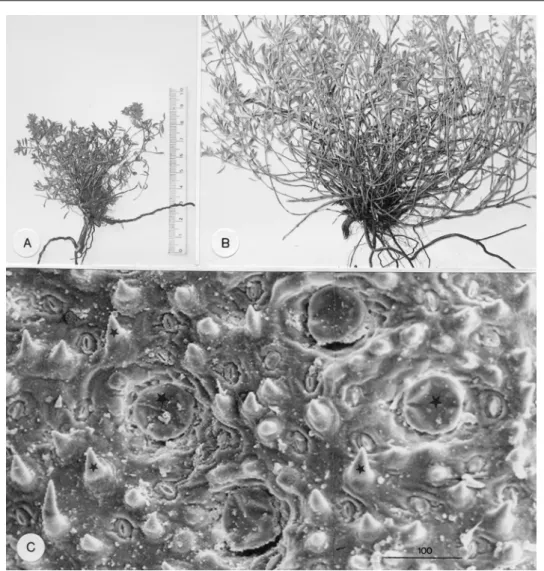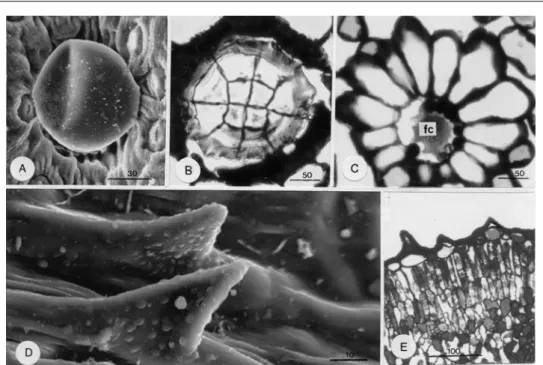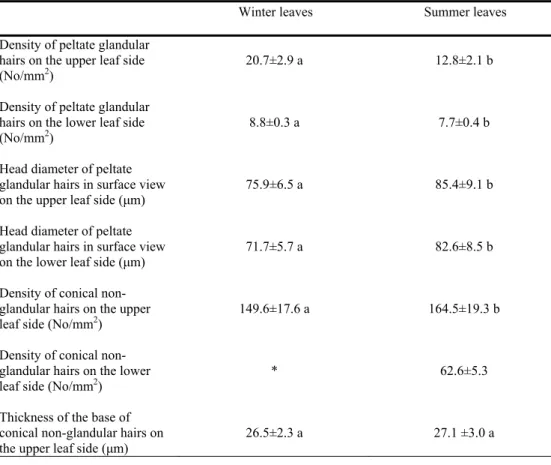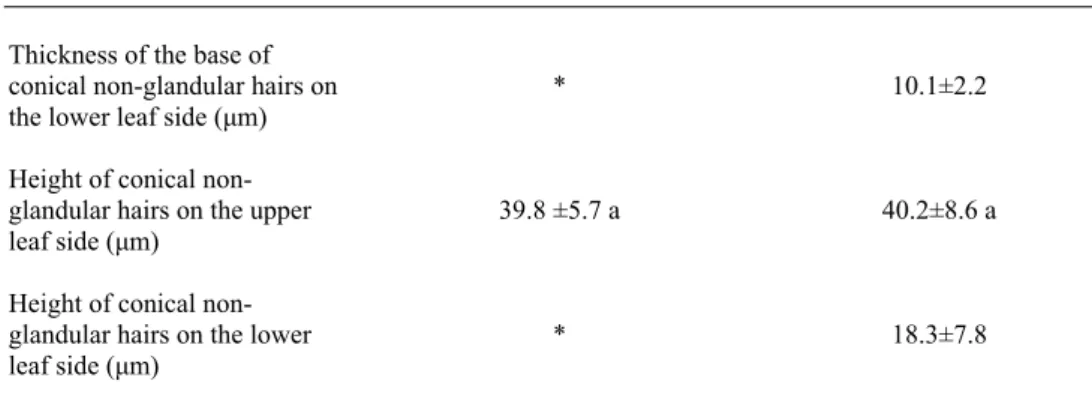3 J. Plant Develop.
20(2013): 3 – 11
GLANDULAR HAIRS, NON-GLANDULAR HAIRS, AND
ESSENTIAL OILS IN THE WINTER AND SUMMER LEAVES OF
THE SEASONALLY DIMORPHIC
THYMUS SIBTHORPII
(LAMIACEAE)
BOSABALIDIS ARTEMIOS Michael1
Abstract: The structure and function of the glandular and non-glandular hairs, and also the yield and chemical composition of the essential oils in the winter and summer leaves of the seasonally dimorphic plant
Thymus sibthorpii were studied. Glandular hairs comprise peltate hairs only (capitate hairs are missing). Peltate hairs are the sites of essential oil biosynthesis. They are more numerous in the winter leaves than in the summer leaves and consist of a 12-celled secretory head, a unicellular stalk, and an also unicellular epidermal foot. The essential oil of the winter leaves is mainly composed of linalool (42.4%), thymol (7.0%), p-cymene (5.8%), -caryophyllene (5.7%), borneol (5.6%), and terpinen-4-ol (4.8%). The oil of the summer leaves is principally constituted of p-cymene (25.0%), linalool (19.1%), terpinen-4-ol (8.5%) and borneol (8.3%). Non-glandular hairs proliferate in the summer leaves. They are conical in shape and consist of one basal epidermal cell and one apical pointed cell. Glandular and non-glandular hairs are implicated in the chemical and mechanical defense of the plant, respectively.
Keywords: anatomy, leaf hairs, Thymus sibthorpii.
Introduction
The aerial organs of many plants are covered with hairs which exhibit a great diversity in shape, size, structure and function. According to WEISS’s (1867) definition, plant hairs are structures which owe their origin to outgrowths of single epidermal cells, eventually accompanied by divisions. Similarly, UPHOF (1962) considers that the name “trichome” should be applied to all outgrowths of the epidermis of leaves, shoots and roots, no matter whether they are unicellular or pluricellular. The distinction of plant hairs into “glandular” and “non-glandular” which is largely used today, has its origination to SOLEREDER (1908).
The functional role of plant hairs is multifarious. Non-glandular hairs were found to have an implication in reduction of transpiration and leaf overheating, and also in protection from UV-B radiation [MANETAS, 1999]. Their principal role, however, is mechanical protection against various predators, and particularly the insects (obstacles in insect movement, feeding, and oviposition on leaves) [GOERTZEN & SMALL, 1993]. Glandular hairs, on the other hand, exert chemical protection by secreting different kinds of secondary metabolites which may be repellent and lethal to insects, skin irritant and deleterious to mammals, and toxic to microorganisms [ROSENTHAL & BERENBAUM, 1991; AZAZ & al. 2004].
1
4
The objectives of the present work comprised determination of the types of glandular and non-glandular hairs in Thymus sibthorpii and examination of their anatomy, in order to compare them with other Thymus species. Moreover, the size, density distribution, and morphometry of the hairs, as well as the chemical constitution of the secreted essential oils were studied in winter and summer leaves in an attempt to find out whether low and high temperatures have any possible effects on these parameters. The obtained data would provide useful information to taxonomists dealing with plant hairs, and also to ecologists working on plant adaptation.
Materials and methods
Plant material and sampling
Native plants of Thymus sibthorpii Bentham (Lamiaceae) were studied in the region of Ormylia, Chalkidiki, N. Greece (N 40°16'53", E 23°31'43", altitude 51m a.s.l.). In this region, the meteorological data in the three years of study (2009-2011) showed that during the winter months the average daily air temperature was 7.3 °C, the average daily relative air humidity 78.0%, and the average daily rainfall 1.9 mm. During the summer months, the climatic conditions were mild (not hot and dry) with an average daily air temperature of 24.3 °C, an average daily relative air humidity of 63.3%, and an average daily rainfall of 1.0 mm. Meteorological data were provided by the Regional Center for Plant Protection and Quality Control, Thermi, Thessaloniki, Greece. Winter sampling was performed in January and summer sampling in July. Fully-expanded leaves of annual shoots were used (3rd node from the shoot basis).
Microscopy
From a sample of 18 leaves (3 leaves x 6 plants), 5 leaves were randomly selected for light microscopy (LM), and another 5 leaves for scanning electron microscopy (SEM). Leaves for LM were cut into small pieces which were subsequently fixed for 3h with 5% glutaraldehyde in 0.05 M phosphate buffer (pH 7.2). After washing in buffer, the specimens were post-fixed for 4h with 2% osmium tetroxide, similarly buffered. Samples were then dehydrated in an ethanol series (50-100%) and finally embedded in Spurr’s resin. Semithin sections (1 μm thick) of plastid embedded tissue were obtained with a Reichert Om U2 microtome (Reichert Optische Werke AG, Vienna, Austria), stained with Toluidine Blue O and photographed on a Nikon Eclipse ι80 light microscope (Nikon Instruments, Amstelvee, The Netherlands). For SEM, the specimens, after fixation and dehydration, were critical-point dried in a Balzers CPD 030 device (Balzers Union AG, Liechtenstein) and then carbon-coated in a Jeol JEE-4X vacuum evaporator. Observations were made with a Jeol JSM 840-A scanning electron microscope.
Morphometry
The densities (No/mm2) of the glandular and non-glandular hairs on both surfaces of the winter and summer leaves were determined using 36 SEM micrographs. These micrographs were also used for conducting morphometric assessments on the hairs.
Essential oils
5
0.25 mm i.d., film thickness 0.25 μm). The temperature program ranged from 50 °C to 290
°C, at a rate of 4 oC/min. Helium was used as a carrier gas at a flow rate of 1.0 ml/min. Injection volume of each sample was 1 μl. Arithmetic indices for all compounds were determined using n-alkanes as standards [VAN DEN DOOL & KRATZ, 1963]. Relative percentage of separated compounds was calculated from total ion chromatogram by a computerized integrator. The identification of the components was based on comparison of their mass spectra with those of NIST21 and NIST107 [MASSADA, 1976], and on comparison of their arithmetic indices with literature data [ADAMS, 2007]. Essential oils were often subjected to co-chromatography with authentic compounds (Fluka, Sigma).
Statistics
Statistical analysis was performed with the SPSS package (SPSS Inc. Chicago, USA) using ANOVA for comparison of means between treatments. Significance was determined at p≤0.05 probability level.
Results
Thymus sibthorpii plants have an entirely different appearance in winter and summer (Fig. 1A, B), a fact principally due to the different environmental conditions prevailing in each of these seasons. Thus, winter plants (Fig. 1A) compared to summer plants (Fig. 1B) are greatly smaller, with shorter densely-arranged shoots and shorter, dark-green leaves. Scanning electron microscopy disclosed that both the winter and summer leaves bear on their surfaces glandular and non-glandular hairs (Fig. 1C). Glandular hairs consist of essential oil-secreting peltate hairs only (Fig. 1C, large asterisks) with no presence of capitate hairs. Peltate hairs are more numerous in the winter leaves (Tab. 1) and they are constructed of a 12-celled secretory head (Fig. 2B), a unicellular stalk and an also unicellular epidermal foot. The 12 head cells are arranged in such a manner that 4 small cells are located in the centre of the head and 8 large ones in the periphery. The foot cell is radially surrounded by 13-15 elongated epidermal cells (Fig. 2C). Non-glandular hairs proliferate in the summer leaves and particularly on their upper side (Tab. 1). They are of one type only, i.e. short conical structures covered with granula (Fig. 1C, small asterisks; Fig. 2D). Their size (height, thickness) does not appear to differ between the winter and summer leaves. Anatomically, non-glandular hairs are composed of one large basal cell located at the level of the epidermis and one pointed cell sited above it (Fig. 2E).
6
7
Fig. 2. A. SEM view of a peltate hair. B. Paradermal section of the head of a peltate hair. The head consists of 12 cells. C. Paradermal section of the foot cell (fc) which appears radially surrounded by 13-15 elongated epidermal cells. D. Non-glandular hairs as they appear in SEM. E. Longitudinal section of non-glandular hairs composed of a large basal epidermal cell and a small apical pointed cell. Bars in μm.
Discussions
SEM observations on the blade surfaces of the winter and summer leaves of
8
The elongated epidermal cells which radially surround the foot cell of each peltate hair (peribasal cells) are considered as a fundamental accessory of the hair. Thus, the large surface area defined by the radial arrangement of the peribasal cells, their convergence towards the foot cell, and their location at the border with the mesophyllic photosynthetic parenchyma, favour the interpretation that peribasal cells collect from the mesophyll photosynthates which become centripetally transferred first to the foot cell (large central vacuole) and then to the apical head cells. There, they will constitute the precursors for the biosynthesis of the essential oil.
Qualitative analysis of the essential oils from T. sibthorpii winter and summer leaves showed that in both types of oils the major components are linalool and p-cymene. Linalool dominated in the winter leaves and p-cymene in the summer leaves. The high content in linalool of the thyme oil is ascribed by VERNET & al. (1986) to the low environmental temperatures (winter conditions). In accordance to our results, high contents of p-cymene, -terpinene, borneol, and terpinen-4-ol were also recorded by VOKOU (1993) in the oil of the summer leaves of T. capitatus.
Tab. 1.Thymus sibthorpii. Morphometric assessments of peltate glandular hairs and conical non-glandular hairs in fully expanded leaves of winter and summer (±SD, n=36).
Means between columns with different letters are significantly different at 0.05 level Winter leaves Summer leaves
Density of peltate glandular hairs on the upper leaf side (No/mm2)
Density of peltate glandular hairs on the lower leaf side (No/mm2)
Head diameter of peltate glandular hairs in surface view on the upper leaf side (μm)
Head diameter of peltate glandular hairs in surface view on the lower leaf side (μm)
Density of conical non-glandular hairs on the upper leaf side (No/mm2)
Density of conical non-glandular hairs on the lower leaf side (No/mm2)
Thickness of the base of conical non-glandular hairs on the upper leaf side (μm)
20.7±2.9 a
8.8±0.3 a
75.9±6.5 a
71.7±5.7 a
149.6±17.6 a
*
26.5±2.3 a
12.8±2.1 b
7.7±0.4 b
85.4±9.1 b
82.6±8.5 b
164.5±19.3 b
62.6±5.3
9 Thickness of the base of
conical non-glandular hairs on the lower leaf side (μm)
Height of conical non-glandular hairs on the upper leaf side (μm)
Height of conical non-glandular hairs on the lower leaf side (μm)
*
39.8 ±5.7 a
*
10.1±2.2
40.2±8.6 a
18.3±7.8
*There are no non-glandular hairs on the lower leaf side of the winter leaves
Tab. 2.Thymus sibthorpii. Qualitative and quantitative compositions (%) of the essential oils from winter and summer leaves
Components a AI b Winter
leaves
Summer
leaves Identification c
α-Thujene 926 n.d. 0.4 AI, MS
α-Pinene 932 n.d. 1.0 AI, MS, Co-GC
Camphene 946 0.2 1.7 AI, MS
Sabinene 972 n.d. 0.2 AI, MS
-Pinene 974 n.d. 0.3 AI, MS, Co-GC
1-Octen-3-ol 980 1.0 0.3 AI, MS
3-Octanone 988 0.5 0.4 AI, MS
-Myrcene 991 0.1 0.2 AI, MS, Co-GC
3-Octanol 997 0.6 0.2 AI, MS
α-Phellandrene 1002 n.d. 0.3 AI, MS
α-Terpinene 1017 0.5 1.7 AI, MS
p-Cymene 1024 5.8 25.0 AI, MS, Co-GC
Limonene 1028 0.5 4.5 AI, MS, Co-GC
1,8-Cineole 1029 1.1 4.4 AI, MS, Co-GC
-Terpinene 1058 2.4 3.6 AI, MS, Co-GC
cis-Sabinene hydrate 1067 0.5 3.2 AI, MS
cis-Linalool oxide
(furanoid) 1072 0.3 0.5 AI, MS
Terpinolene 1087 n.d. 0.8 AI, MS
trans-Linalool oxide
(furanoid) 1087 0.6 0.5 AI, MS
trans-Sabinene hydrate 1095 n.d. 0.5 AI, MS
Linalool 1100 42.4 19.1 AI, MS, Co-GC
cis-Verbenol 1138 0.1 n.d. AI, MS
trans-p-Menth-2-en-1-ol 1138 0.1 n.d. AI, MS
Camphor 1142 0.5 1.0 AI, MS, Co-GC
Borneol 1165 5.6 8.3 AI, MS, Co-GC
Terpinen-4-ol 1176 4.8 8.5 AI, MS, Co-GC
10
α-Terpineol 1190 0.3 0.8 AI, MS
cis-Dihydro carvone 1196 0.1 0.3 AI, MS
trans-Dihydro carvone 1203 0.2 0.3 AI, MS
trans-Carveol 1219 0.1 0.3 AI, MS
Cumin aldehyde 1240 n.d. 0.1 AI, MS
Carvone 1244 n.d. 0.1 AI, MS, Co-GC
Carvacrol methyl ether 1244 n.d. 0.1 AI, MS
Bornyl acetate 1288 0.2 0.2 AI, MS, Co-GC
Thymol 1292 7.0 1.0 AI, MS, Co-GC
Carvacrol 1301 3.9 2.3 AI, MS
Thymol acetate 1355 0.2 n.d. AI, MS
Carvacrol acetate 1374 0.1 n.d. AI, MS
-Bourbonene 1384 0.7 0.5 AI, MS
β-Caryophyllene 1421 5.7 1.4 AI, MS, Co-GC
cis-Cadina-1(6),4-diene 1462 0.2 n.d. AI, MS
9-epi-(E)-Caryophyllene 1462 0.2 n.d. AI, MS
Germacrene D 1482 2.1 n.d. AI, MS
Bicyclogermacrene 1497 2.6 n.d. RI, MS
-Bisabolene 1509 3.8 0.7 AI, MS
Spathulenol 1578 0.7 0.4 AI, MS
Caryophyllene oxide 1583 3.3 2.1 AI, MS, Co-GC
Caryophylla-4(12),
8(13)-dien-5-ol d 1639 0.1 n.d. AI, MS
TOTAL 99.3 97.6
Essential oil yield (%) 1.20 1.11
a Compounds listed in order of elution from an HP-5 MS capillary column; b AI: Arithmetic indices as
determined on a HP-5 MS capillary column using a homologous series of n-alkanes (C9-C25); c Identification method: AI= Arithmetic index. MS=mass spectrum. Co-GC=coinjection with authentic compound. d Correct isomer not identified. n.d.: not detected
Conclusions
Thymus sibthorpii plants bear on their leaves glandular and non-glandular hairs which differ in anatomy from other Thymus species. The structural model of the glandular hairs (peribasal cells, basal cell, head cells) is functionally related to the uptake of photosynthates from the mesophyll and their transportation to the head cells where they constitute precursors for the biosynthesis of the essential oil. In winter leaves, glandular hairs are more numerous and secrete a higher amount of essential oil, compared to summer leaves. Due to the antioxidant properties of the essential oils, the plant can thus tolerate winter low temperatures which stimulate oxidative stress.
Acknowledgements
11
References
ADAMS R. 2007. Identification of essential oil components by gas chromatography/mass spectroscopy. 4th Ed.
Allured Publ. Corp. Carol Stream. Illinois USA.
AZAZ A. D., IRTEM H. A., KURCUOGLU M. & BASER K. H. 2004. Composition and in vitro antimicrobial activities of the essential oils of some Thymus species. Z. Naturforsch. 59: 75-80.
BOZ I., NAVARRO L., GALES R. & PADURARIU C. 2009. Morphology and structure of glandular hairs in development of Thymus vulgaris. L. Anal. Stiin. Univ. Iasi, Biol. Veg. 2: 81-86.
BRUNI A. & MODENESI P. 1983. Development, oil storage and dehiscence of peltate trichomes in Thymus vulgaris (Lamiaceae). Nord. J. Bot.3: 245-251.
GOERTZN L. R. & SMALL E. 1993. The defensive role of trichomes in black medick (Medicago lupulina, Fabaceae). Pl. Syst. Evol.184: 101-111.
MANETAS Y. 1999. Is enhanced UV-B radiation really damaging for plants? Some case studies with European mediterranean species. In Rosema J. (ed) Stratospheric Ozone Depletion: The effects of Enhanced UV-B Radiation on Terrestrial Ecosystems. Backhyus Publ., Leiden.
MARIN M., KOKO V., DULETIC-LAUSEVIC S. & MARIN P. D. 2008. Micromorphology of trichomes of
Thymus malyi (Lamiaceae). J. Microsc. 232: 406-409.
MASADA Y. 1976. Analysis of essential oils by gas chromatography and spectrometry. Wiley & Sons, New York.
McCASKILL D., GERSCHENZON J. & CROTEAU R. 1992. Morphology and monoterpene biosynthetic capabilities of secretory cell clusters isolated from glandular trichomes of peppermint (Mentha piperita
L.). Planta.187: 445-454.
ROSENTHAL G. A. & BERENBAUM M. R. 1991. Herbivores. Their interactions with secondary plant metabolites. Academic Press, San Diego, New York.
SATIL F., KAYA A., BICAKLI A., ÖZATLI S. & TÜMEN G. 2005. Comparative morphological, anatomical and palynological studies on Thymus migricus Klokov & Des.-Shost and T. fedtschenkoi Ronniger var.
handelii (Ronniger) Jalas grown in East Anatolia. Pak. J. Bot. 37: 531-549. SOLEREDER H. 1908. Systematische Anatomie der Dicotyledonen. Erg. Bd., Berlin. UPHOF J. C. T. 1962. Plant hairs. Gebr. Borntraeger, Berlin.
VAN den DOOL H. & KRATZ P. D. 1963. A generalization of the retention index system including linear temperature programmed gas-liquid partition chromatography. J. Chromat. 11: 463-471.
VERNET P., GOUYON P. H. & VALDEYRON G. 1986. Genetic control of the oil content of Thymus vulgaris
L.: a case of polymorphism in a biosynthetic chain. Genetica. 69: 227-231.
VOKOU D. 1983. Essential oils and their role in the phryganic ecosystems. Doctoral Dissertation. Univ. Thessaloniki, Greece.
WEISS A. 1867. Die Pflanzenhaare. Karsten Bot. Unters.1: 369-677.
WERKER E., RAVID U. & PUTIEVSKY E. 1985. Structure of glandular hairs and identification of the main components of their secreted material in some species of the Labiatae. Isr. J. Bot.34: 31-45.
YAMAURA T., TANAKA S. & TABATA M. 1992. Localization of the biosynthesis and accumulation of monoterpenoids in glandular trichomes of thyme. Planta Med.58: 153-158.



